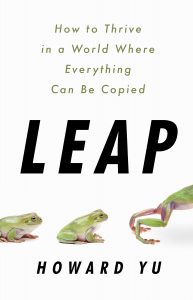Leaping to a New Growth Curve – Part 3 of 3

Recently I had the opportunity to interview Howard Yu, LEGO professor of management and innovation at the prestigious IMD Business School in Switzerland, director of IMD’s signature Advanced Management Program (AMP), and author of the book Leap: How to Thrive in a World Where Everything Can Be Copied to investigate a series of important questions about what we can learn from our history while looking to create our future. Without further ado, here is the transcript of that interview (Part 3 of 3):
9. Why should every company care about the wisdom of the crowd? What can business leaders in every sector learn about leveraging ubiquitous connectivity from China’s largest social media app, WeChat?
As with all things China, the most astounding aspect of WeChat is its rapid ascent. Skeptics dismiss WeChat as just a Chinese WhatsApp or iMessage. Many people outside the country may not have even heard of this service. Still, there are 938 million monthly active WeChat users, a number larger than the entire population of Europe, let alone that of the U.S.. But the size of the user base “doesn’t tell the whole story,†according to a WeChat executive. “You need to count engagement.†WhatsApp, for instance, has more than 1.2 billion users worldwide. Facebook—WhatsApp’s parent company since 2014—has over 2 billion users. But WeChat has proven itself to be more enticing, as more than 1/3 of its users spend four hours or more per day on this app. By contrast, users average 35 minutes on Facebook, 25 minutes on Snapchat, 15 minutes on Instagram, and one minute on Twitter.
This extreme engagement can be explained in large part by the extremely wide scope of services that WeChat provides. Shaking one’s phone via WeChat is a popular way to find new friends who are also users. Waving it in front of a television allows WeChat to recognize the current program and gives viewers the opportunity to interact. WeChat has effectively rolled Facebook, Instagram, Twitter, WhatsApp, and Zynga into one. Instead of being just a stand-alone messaging app, WeChat is an indispensable mobile tool for booking doctors’ appointments, settling hospital bills, filing police reports, reserving restaurant tables, accessing banking services, holding video conferences, playing games, and much more.
None of these features are invented by WeChat engineers. Most WeChat services are in fact provided by third parties. WeChat’s major breakthrough, therefore, is the realization that a product’s best feature is never invented in-house. Killer apps must be invented by users instead.
While the viability of crowdsourcing has been apparent since the early days of Wikipedia, the high level of connectivity today was barely imaginable a decade ago. The accelerated improvement in how people connect with one another has profoundly changed how smart creatives can collaborate on ever more sophisticated projects, which, in turn, influences nearly every business prospect. What was once the personal foray of a single mind can now be transmitted and distributed widely, allowing a whole community to participate. Instead of relying on a small team of internal experts to painstakingly make important decisions, companies must use crowdsourcing to mass-produce solutions and solve complex problems.
 10. In LEAP, you celebrate the looming force of AI. Why should business leaders embrace intelligent machines? Could you share an example of a leap into the realm of AI that made a company stronger and more humane?
10. In LEAP, you celebrate the looming force of AI. Why should business leaders embrace intelligent machines? Could you share an example of a leap into the realm of AI that made a company stronger and more humane?
The current development of AI can be likened to the early years of electricity when it replaced steam power in manufacturing. At the turn of the century, most textile factories were still powered by flowing water and waterwheels. Factories that installed steam engines had to use pulleys, belts, rotating shafts, and a host of complex gear systems. Factories were built largely around a rigidly imposed steam engine, impairing any possible workflow efficiency. Interestingly, when manufacturers began to use electricity, engineers couldn’t imagine an alternative layout like the modern-day assembly line. Instead, they grouped electric motors in a big cluster, forgoing the benefit of decentralized power to optimize workflow. It took almost another two decades before manufacturers were able to unleash the full benefits of electricity.
Today, big organizations still think of AI as a cost-cutting measure that substitutes human labor in paper processing. Although this can be all-important, the biggest potential is likely to be augmentation—freeing up managers from white-collar drudgeries so they can engage more in creative and emphatic activities.
The upshot is that artificial intelligence, machine learning, and cognitive computing can exert either a complementary effect or substitutional pressure. But that outcome is not predetermined. Atul Gawande—a celebrated surgeon, writer, and public health researcher—explained exactly why human interaction remains paramount in the age of AI. He shared a simple scenario at a local clinic. “I have pain,†a patient complains. “Where?†the doctor asks. “Hmmm. Well, it’s sort of here.†The patient points with one hand. “Well, do you mean there under your rib cage, or do you mean in your chest, or your stomach . . . ?†To Gawande, this intimate interaction is as much about a patient telling her story as it is about a doctor probing a patient. “It’s more of a narrative than it is a straight set of data.†A physician needs “not only to ask you to take off your clothes, but then to actually have permission to cut you open and do what [he] choose[s] to do inside you.†Trust, empathy, and dialogue are what make health care ever so human—that only we can fully grasp the meaning of compassion, pride, embarrassment, envy, justice, and solidarity.
Sebastian Thrun, a computer scientist and pioneer in self-driving cars explains “When you use a phone, you amplify the power of human speech. You cannot shout from New York to California, and yet this rectangular device in your hand allows the human voice to be transmitted across three thousand miles. Did the phone replace the human voice? No, the phone is an augmentation device.â€
As improbable as it may seem, a good example is found in Japan, with a Japanese publisher. Established in the early 1960s, Recruit Holdings started as an advertising company publishing magazines for job seekers. Spurred by the Internet revolution in the early 2000s, the company added business verticals, such as real estate, bridal, travel, beauty salon, and restaurant. By 2015, as Recruit’s digital platforms gained popularity, the company noticed the enormous amounts of online data on types of transactions and end-user behaviors. By establishing an artificial intelligence (AI) research laboratory in Silicon Valley, Recruit’s management started to apply the latest technologies in data analytics and machine learning.
Amid all the changes, one major shift at Recruit was the changing role of sales. In the past, customers placed ads to drive traffic to stores. Today, all the digital platforms are used as new means to improve business efficiency. Sales personnel no longer mindlessly canvass towns, touting advertising space to proprietors. Instead, they collate customer insights and act as champions of technology requirements, effectively multitasking as general problem solvers—a far more varied, sophisticated, and enriching job for employees.
 11. Why is managerial creativity increasingly important?
11. Why is managerial creativity increasingly important?
To gain any groundbreaking insights into marketing, consumer psychology, popular art, or even a mobile app’s user interface, an innovator is still necessary to synthesize human experience, newspaper articles, and stories about how people have reacted, conversed, and complained. Extracting hidden and ambiguous meanings in the social realm requires not just big data, which are often broad and shallow and devoid of emotional meanings, but also small data—the thick and deep information about individuals, for example, about how a sickly child at the hospital is nervously waiting for an MRI scan.
Machine learning and big data concern themselves with correlation, not causation. Under the hood of IBM Watson, for instance, an algorithm establishes many statistically significant relationships but never quite explains why they are so. The way we assess the performance of computer systems can also be misleading. The notion of machine intelligence, strangely enough, remains ill-defined. Scientists tend to evaluate a computer’s performance based on tasks that are difficult for humans, such as playing chess, Go, or Jeopardy! These tasks are unnatural and difficult for humans because they require deliberation and planning—the type of cognitive work that our evolutionary history has endowed us with only most recently. These are not the sort of tasks that human intelligence has evolved for—making very quick decisions using limited sensory data with limited calculation power. Consequently, a computer can play chess far better than it can recognize the face of its opponent.
Precisely because people are more agile and dexterous than the most advanced robots in identifying objects and understanding nuances, the results are always better when computers and humans work together, rather than when either one does it alone, whether it is playing chess or solving other real-world problems. You can try pushing a machine toward the bleeding edge, but it still won’t beat an average machine that works alongside a human. The future is merging machine capability and human consciousness. Each doing their best work and managerial creativity is the human advantage.
12. How can readers start taking first steps toward making a leap tomorrow?
In order to leap, you must make concrete choices. A bold decision always looks good—until it is proved wrong. To borrow Donald Rumsfeld’s phrase of “unknown unknowns,†executives may not even be aware that they don’t possess a critical piece of information. To facilitate evidence-based decision making, therefore, managers must carry out frequent experimentation to reduce the dark space of ignorance and to arrive at conclusions with the required level of familiarity.
Here’s another way of looking at it. The biggest risk that threatens the survival of a large and complex organization is political infighting and collective inaction. Arguments that play out in the boardroom may be akin to empty rhetoric and amount to nothing more than personal beliefs. Experimentation is the window of truth that will let light in from outside.
And yet market leadership can’t be achieved through an undirected process of boundless experimentation, nor can it result purely from the efforts of skunkworks or corporate ventures directly imported from Silicon Valley. Behind any unfocused effort lies a bleak prognosis: the established organization has become so dogmatic and unchangeable—insidious at worst—that the only way to innovate is to put a few bright people in a dark room, pour in some money, and hope that something wonderful will happen. This freewheeling approach may work well for venture capitalists because they invest to exit, either through initial public offerings (IPOs) or by selling start-ups to large firms. But an established organization should invest and innovate to rejuvenate its ongoing business ahead of its competition. Integration of the old and the new becomes unavoidable. For this reason, sooner or later, the senior executives of an operating company have to call the shots and turn an emergent exploration into a deliberate execution.
Once the winning strategy becomes clear, the company must pursue it aggressively. Not doing so is tantamount to failed leadership.
Final Words
LEAP began as a historical account, a memoir of Western pioneers. Some of these pioneers failed, some survived, others prospered. But it’s also a playbook for the future. More importantly, it’s a manifesto for how pioneering companies can rethink their businesses, their relationship with their customers, and the reasons they exist. Any organization — large or small — has a set of traditional strengths and important products that have helped build it into what it is today. There is no perfect moment to innovate. But everyone has exactly enough time, starting now.
Wait! Before you go…
Choose how you want the latest innovation content delivered to you:
- Daily — RSS Feed — Email — Twitter — Facebook — Linkedin Today
- Weekly — Email Newsletter — Free Magazine — Linkedin Group
 Braden Kelley is a popular innovation speaker, builds sustainable innovation cultures, and tools for creating successful change. He is the author of the five-star book Stoking Your Innovation Bonfire and the creator of a revolutionary new Change Planning Toolkit™. Follow him on Twitter (@innovate) and Linkedin.
Braden Kelley is a popular innovation speaker, builds sustainable innovation cultures, and tools for creating successful change. He is the author of the five-star book Stoking Your Innovation Bonfire and the creator of a revolutionary new Change Planning Toolkit™. Follow him on Twitter (@innovate) and Linkedin.
NEVER MISS ANOTHER NEWSLETTER!
LATEST BLOGS
Four ways you can ensure employees take accountability for their work
One of the most important driving factors for any successful business is a high-performing team. Having people working for you…
Read MoreWhat is digital upskilling and why is it important?
Photo by Annie Spratt on Unsplash In a world of business that never stands…
Read More


